Final report for FW22-389
Project Information
Can the addition of clay to compost feedstocks increase fines, and carbon and nutrient retention in finished compost? We asked this question after a talk by Dr.Griffin LaHue on soil carbon and clay’s role in carbon sequestration coupled with our observation of a loss of fines around aeration pipes in finished compost in our positively aerated compost system. Challenges meeting customer expectations regarding the ratio of fines to woody material in our finished compost prompted further investigation. We discovered research claiming that clay integrated with compost feedstocks increases compost quality and its ability to sequester carbon in soils (Barthod et al., 2016; Bolan et al., 2012; Chen et al., 2018; Coleman 1995).
Montmorillonite clay and farm-sourced clay will be added to compost feedstocks in a controlled, replicated experiment in specially made compost bins. The finished composts will be tested for agronomic mineral concentrations, carbon content, particle size distribution and cation exchange capacity (CEC). These composts will be utilized in growing media for lettuce seedlings in a triple replicated trial, with lettuces tested for nutrients and yield assessed by wet and dry weight.
Through professional videos, social media, conference presentations and on-farm demonstrations, Midnight’s Farm will share research results, and enable other farmers to build and use aerated static pile compost systems.
Building on successful past collaborations, our team is uniquely qualified to carry out both the research and associated outreach to bring new understanding of carbon stability to the age-old practice of making and using compost.
In consultation with Dr. Collins and other soil scientists, our primary objective is to test the hypothesis that adding clay to compost feedstock will improve the physicochemical properties of finished compost. In collaboration with Dr. Siegner, we will educate farmers, ranchers, composters, and researchers about the process and results from this project through videos, articles and conference presentations.
Our research will primarily assess how the addition of clay to a compost feedstock alters the nutrient density and carbon retention of finished compost. We also intend to develop a mechanism to disperse clay at scale into compost feedstocks; to assess clay co-composts (Co-composting is the controlled aerobic degradation of organics, using more than one feedstock) as growing media ingredients on quality and yield of lettuce seedlings; and to demonstrate an easily replicated small aerated compost system. We will utilize diverse forms of outreach with goals of reaching 5,000 producers, agriculture professionals and researchers through professional videos, conference presentations, and articles in respected producer journals. We will conduct on-farm education for local farmers, farm interns, professionals, and local high school students.
Cooperators
- - Producer
- - Technical Advisor
- (Educator)
- (Educator and Researcher)
- - Technical Advisor (Researcher)
Research
The primary research goal is to test the hypothesis that adding clay to compost feedstock will improve the physicochemical properties of finished compost (e.g. higher nutrient concentration, increased fines, better retention of carbon) through the formation of Mineral Associated Organic Matter (MAOM) which is less susceptible to biological degradation (respiration) during the composting process.
Objective 1:
To assess how the addition of clay to a compost feedstock alters the physicochemical properties of the finished compost. (e.g.,, nutrient concentration, particle size distribution and carbon retention)
Feedstocks
The feedstocks for the compost trials were a mixture of ground yard debris, cattle bedding and manure. The bulk density of the feedstock was 421 lb/yard (method: TMECC 03.10 A).
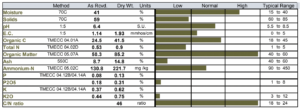
Treatments and Replicates
The first replicate was started on 10/7/22 and included four separate compost bins with the following treatments:
- Local clay silt addition 5% clay equivalent by dry weight of feedstock.
- A control with only the feedstock.
- Biochar addition 8% by dry weight of the feedstock (this was not in our proposal and was not triple replicated)
- Montmorillonite addition 5% by dry weight of the feedstock.
The second and third replicates were started on 11/15/22 in six bins with the following treatments:
- Local clay silt addition 5% clay equivalent by dry weight of feedstock.
- A control with only the feedstock.
- Montmorillonite addition 5% by dry weight of the feedstock.
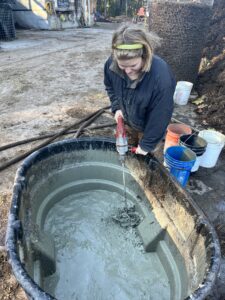
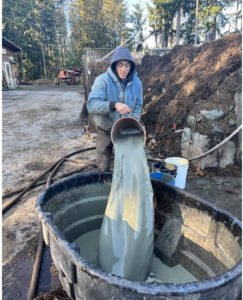
To blend the clay with the other compost feedstocks, we mixed the clay in 150 gallon cattle water tanks with a paint mixer connected to a drill motor. The clay slurry was added with a bucket and then additional water was added to the feedstock with a pressure hose to reach the desired moisture content. (roughly 60%). The material was mixed both by hand and with a bucket loader against the mixing wall.
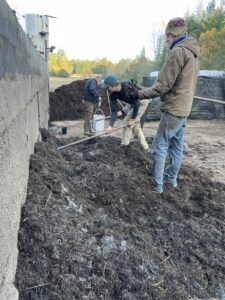
Bulk Density Tests
In our original proposal, we stated that each clay addition will be made into a slurry with 15 gallons of water and well mixed with feedstock to fill one bin. However, we instead performed bulk density tests on each of the bin mixtures in order to gauge their moisture and ensure they were all similar. We followed a Washington State University guide to perform the test (https://puyallup.wsu.edu/soils/bulkdensity/).
Our goal was for each bucket to be 10 kg. After that measurement, we calculated the bulk density.
Bulk density of Local Clay compost: 776.028 lbs/yd3
Bulk density of Control compost: 873.032 lbs/yd3
Bulk density of Biochar compost: 858.04 lbs/yd3
Bulk density of Montmorillonite Clay compost: 960.32 lbs/yd3
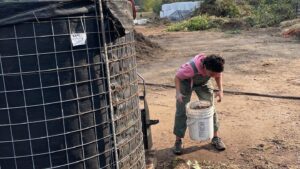
Aeration
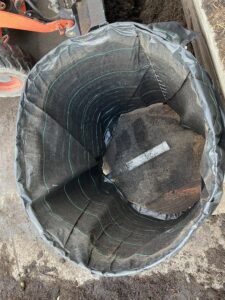
Airflow was supplied by 4” diameter PVC piping with 8 half inch (2 rows of 4 holes) aeration holes situated at the bottom of the composting bins. The pipes were covered by a permeable fabric so the air did not escape to the sides and instead moves up into the bins. Blowers, controlled by timers, supplied the aeration pipes. Each blower’s power was 380W.
At the beginning of the initial run, the blowers were all on the same timer. We found that there were times where one bin wouldn’t be getting up to the temperature range we wanted, so we would want to reduce air flow for that bin in particular. We then decided to put all four bins on their own timers. That way, we could adjust each bin separately if one is getting too warm or too cold. We started the air blowing at 2 min every hour and logged each change.
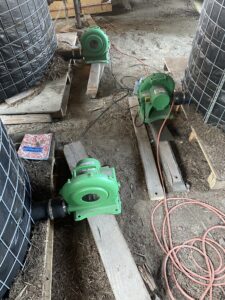
Temperature Monitoring
To allow for real-time web-based temperature monitoring (and hence afford appropriate airflow control) each bin was equipped with DS18B20 outdoor water-proof probes that wirelessly posted data to a web-based data logger (Manufactured by Co Gadgets LLC). We calibrated all the probes to 31F before placing them in their corresponding bins. The probes were set to record every ten minutes. For the first four days and after each turn, we attempted to reach a range of 131º - 145º F.
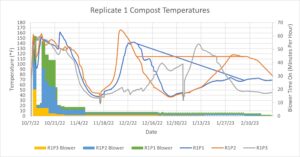
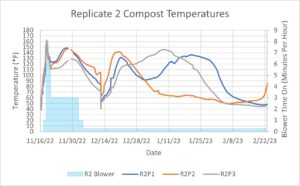
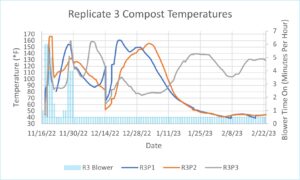
Turning Compost
Each replicate was emptied, rewetted and remixed after approximately one month and then composted an additional month.
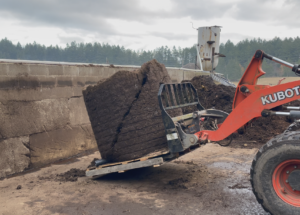
Sampling
After removing the cattle panel and opening the compost bin we found that the finished compost would stay in its cylindrical shape. We used a saw to cut out two opposing eighths which we mixed together. From there we used the standard cone and quarter process to obtain our sample.
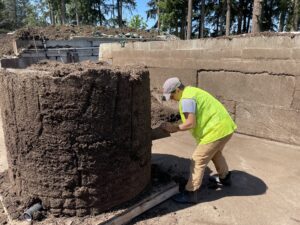
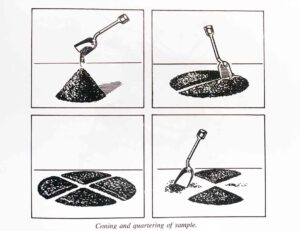
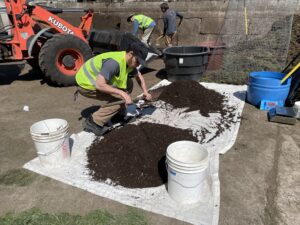
Testing
Samples from feedstocks and from each replicate were sent to Microbial Matrix for analysis of bacteria, fungi and protozoa and to Soil Test Labs for physicochemical analysis.
Objective 2:
To develop an efficient mechanism to disburse local clay into compost feedstocks at scale.
With the local clay and the montmorillonite we made a slurry by slaking the clay in stock tank and then mixing with a paint mixer on a drill. In the initial run, we simply used buckets to add the slurry to the feedstock. In a subsequent test, we used a submersible sump pump to apply the clay slurry. This pump method worked well and could be used at scale, though the pump likely needs to be designed to withstand the abrasion.

We spent considerable time repurposing a 500 gallon propane tank into a mixing chamber. In the first attempts, nozzles inside the base of the standing tank were installed to create a mixing vortex. A 2 hp electric pump pressurized water into the nozzles through 1 ½ inch hoses. The clay was added into the tank, top replaced and sealed, and the pump supplying fresh water, turned on. It was hoped that the pressured water would create a vortex in the tank, mix with the clay, and come out of the tank as clay-infused water with sufficient pressure to allow spraying on the compost. Unfortunately, the desired mixing didn't occur and we found it exceedingly difficult to seal the top of the tank.
Subsequent attempts were made with this tank elevated, allowing the "clay infused" water to flow by gravity to the compost pile. This required adding the clay to the tank with the excavator, which was difficult. With the continued difficulty with mixing the water and clay, we added a mixer into the bottom of the tank. It was a small propeller from a discarded outboard motor attached to a long rod which was supported in the middle of the bottom of the tank and attached to a heavy duty drill motor at the top. This worked to mix the water and clay consistently. The gravity system did not have enough pressure distribute the clay infused water on the feedstock in an efficient manner.
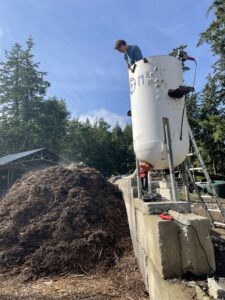
Objective 3:
To demonstrate, compare, and document effects of growing media made with compost or co-composts on media quality and the nutrient density and yield of lettuce seedlings.
The recipe for a 6 gallon batch of our growing media was:
- 3 gallons of compost or co-compost screened to ½ inch,
- 2 gallons of aged wood fines screened to ½ inch, and
- 1 gallon of biochar
- 0.36 lbs of organic 7-2-4 fertilizer.
For our experiment we made batches of growing media from the control, the local clay and the montmorillonite composts (we also included a biochar co-compost treatment that was not officially part of the project).
Then our process was:
- Three 72 cell winstrip trays per treatment were filled with each growing media, which resulted in 12 trays total.
- We seeded little gem lettuce one seed per cell into each tray, watered all trays.
- Trays were placed into the germination chamber on 8/09/2023 at 9:30am. The germination chamber settings were at 74 degrees F and 91.5% RH.
- The trays were removed from the germination chamber on 8/11/23 at 11:30 am and placed in light racks until 9/5/23.
- We sampled 25% of the 72 cell tray which was 18 plants. We used a random number generator to choose our sample cells. Due to observed lack of edge effect we sampled from the whole tray. There were some trays that had less germination in the interior of the tray.
- We recorded the wet weight of the lettuce samples and sent them to Soil Test Labs for tissue analysis.
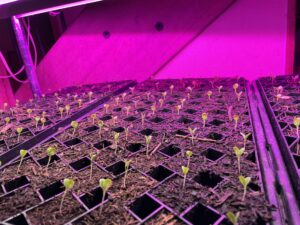
Objective 4:
To prove a design of an easily replicated aerated compost system suitable for small batch (approximately 3 yds) farm and experimental use.
The design perameters:
- affordable (materials under $600),
- easy to assemble (less than 4 hours for two people),
- easy to fill and empty,
- mobile (with forks on a tractor), and
- have a mass to surface area ratio large enough to assure the compost will get up to 131℉ during the winter.
Building the Experimental Compost Bin
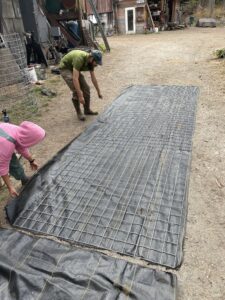
We began with 5'x5' ft wood pallets that the bins would rest on. (This required adding onto a more readily available 4'x4' pallet.) For the cylindrical bin, we used 16'x5' ft galvanized metal mesh cattle panels lined with woven black plastic landscape fabric. We used a piece of high tensil wire to attach the plastic onto the metal panel by loosely threading the fabric onto the panel. After the plastic was attached, we rolled the panel into a cylinder. To create the cylindrical shape we inserted a metal rod through metal rings attached to the panel. (Full details are described in the video.)
Cost breakdown of compost bin, aeration and wireless temp monitoring equipment
| Material | Cost | Source | Notes |
| Cattle Panel | $30 | Tractor Supply | |
| Landscape Fabric | $80 | Tractor Supply | 6 ft x 50 ft roll |
| Pallet | Free | ||
| Temperature Probe | $49 | wirelesstag.net | Wireless Tag |
| Ethernet Tag Manager | $50 | wirelesstag.net | |
| Bouncy House Blower | $60 | Amazon | Get the lowest Watt and cheapest |
| 4 inch Perforated Drain Pipe | $20 | Home Depot | 10 ft length |
| 4 inch Rubber Coupling | $10 | Home Depot | |
| BN-Link Intermittent Timer | $27 | Amazon | |
| Small Carabiners x 4 | $4 | Amazon | We also used wire we crimped into a circle. |
| Rebar 2 foot lengths x2 | $8 | Home Depot | Any metal rod will work |
| Total | $338 |
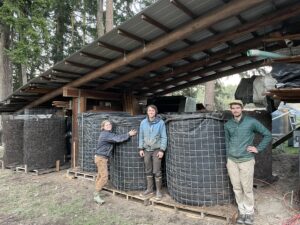
Objective 1:
To assess how the addition of clay to a compost feedstock alters the physicochemical properties of the finished compost.
Quantitative Results
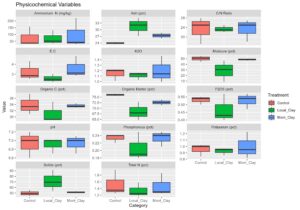
Organic Matter (OM) is statistically significant (Probability value of 0.051). It shows there is at least a signature of the clay addition. OM is the inverse of Ash, which has the same Probability value of 0.051. The unamended finished compost contained more organic matter than either of the clay amended products and this likely reflects a dilution: adding clay increases weight which reduces the percent organic matter in the respective treatments. When we included clay as a compost feedstock, the carbon content of the final product did not increase, in fact there were very little observed differences between treatments. Except for percent ash, the addition of clay had very little effect on the other physicochemical properties we evaluated. Because ash is a measure of mineral content, and both of our treatments included the addition of a clay mineral, the increases observed there are not unexpected.
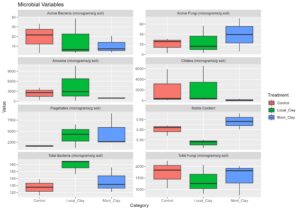
The analysis of the bacteria, fungi and protozoa show such a large variability and spread of data that the results are inconclusive. We did observe differences in moisture of finished compost between replicates and wonder if moisture could be as much a contributing factor to variability as the treatments.
Sieve Analysis
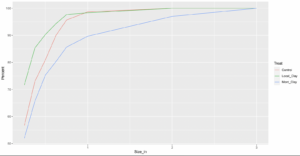
This research project was partially motivated by an observation of reduced fines around our aeration pipes when we aerated our finished compost. Was this the result of those finer organic materials continuing to respire? Would the addition of clay “protect” the fines through some process of mineral associated organic material and result in a more stable, and finer compost?
The sieve analysis, carried out by Soil Test Labs, showed mixed results. The montmorillonite co-compost had the least fines passing through the sieve. The local clay co-compost had the most fines passing through the sieve and might support the hypothesis. The control was right there in the middle. Given the “stickiness” of the montmorillonite, and our challenge screening the material with our ⅞ inch opening on our trommel, it’s tempting to discount the montmorillonite data and claim some small support for our hypothesis.
Qualitative
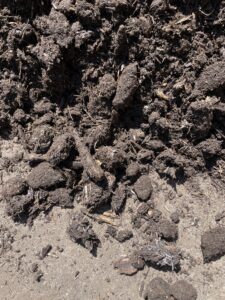
Our experience with the montmorillonite was that it was hard to mix thoroughly with the feedstock. When we added the slurry to the feedstock, it tended to seal the feedstock and not mix very well. There were many clumps of feedstock wet with the water and clay along with portions of feedstock which were very dry. Breaking up these clumps was challenging, took extra time and still may not have resulted in even distribution of the montmorillonite. The local clay didn’t mix up into as thick and sticky a slurry as the montmorillonite, so it was easier to mix with the feedstock. On the third replicate we hydrated the montmorillonite the previous day which made it easier to mix.
While mixing the montmorillonite with the feedstock initially and when rewetting and turning, we noticed many sticky clumps. Breaking these clumps open revealed bits of clay at their center. This observation made us question how well the clay was integrated into the feedstock.
After a month of composting there was noticeable growth of mycelium around the clay clumps especially in the montmorillonite compost.
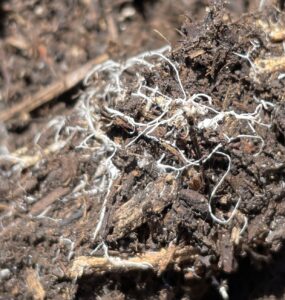
Objective 2:
To develop an efficient mechanism to disburse local clay into compost feedstocks at scale.
Given a) our challenges described above regarding this objective, b) the less than convincing experimental results, and c) the challenges screening the clay co-compost, we honestly put pursuing this objective on hold.
That said, utilizing a powered mixing device in a tank sized appropriately for a loader, with an appropriate secondary pump to disperse a clay slurry could likely be successful. Some modest inline screen/filter, prior to pumping could be more accommodating of impurities, preserve the pump and avoid clogging any spray apparatus.
Objective 3:
To demonstrate, compare, and document effects of growing media made with compost or co-composts on media quality and the nutrient density and yield of lettuce seedlings.
Quantitative
Table 1. Germination rate of lettuce grown in 4 different media (n=3)
|
Compost used in growing media formula (recipe above) |
Percent of cells germinated on 8/11 when removed from germination chamber |
Total Germination on 9/5 |
|
Local Clay Co-compost |
45.4 % |
60.2 % |
|
Control Compost |
51.4 % |
71.3 % |
|
Mont. Clay Co-Compost |
38.4 % |
47.4 % |
|
Biochar Co-Compost |
68.1 % |
75.5 % |
Lettuce germination rate
The germination rate of the montmorillonite growing media had reduced germination rate and visible less vigor. The biochar growing media had the highest germination rate and best observed vigor.
Table 2. Wet weight of lettuce leaf grown in 4 different media (n=3)
| Compost used in growing media formula (recipe above) | Tray # | Wet Weight (oz) |
| Local Clay | 1 | 0.96 |
| Local Clay | 2 | 0.96 |
| Local Clay | 3 | 1.28 |
| Total Clay Weight | Total Clay Weight | 3.2 |
| Control | 4 | 1.12 |
| Control | 5 | 1.92 |
| Control | 6 | 1.12 |
| Total Control Weight | 4.16 | |
| Mont. | 7 | 1.44 |
| Mont. | 8 | 1.28 |
| Mont. | 9 | 1.28 |
| Total Mont. Weight | 4.16 | |
| Biochar | 10 | 1.6 |
| Biochar | 11 | 1.6 |
| Biochar | 12 | 0.96 |
| Total Biochar Weight | 4.32 |
Table 3. Elemental content in lettuce leaf after growth in three different media (n=3)
|
Element |
Control |
Local Clay |
Montmorillonite Clay |
|
Total-N (%) |
2.60 |
2.41 |
2.92 |
|
Phosphorus (%) |
0.64 |
0.60 |
0.82 |
|
Potassium (%) |
6.87 |
6.12 |
7.53 |
|
Sulfur (%) |
0.20 |
0.16 |
0.20 |
|
Calcium (%) |
0.79 |
0.78 |
0.79 |
|
Magnesium (%) |
0.36 |
0.34 |
0.36 |
|
Boron (mg/kg) |
28.00 |
24.00 |
29.00 |
|
Zinc (mg/kg) |
47.00 |
40.00 |
50.00 |
|
Manganese (mg/kg) |
73.00 |
66.00 |
61.00 |
|
Copper (mg/kg) |
5.00 |
6.00 |
5.00 |
|
Iron (mg/kg) |
129.00 |
272.00 |
135.00 |
|
Sodium (%) |
0.41 |
0.39 |
0.67 |
Except for Iron, no major differences between treatments were observed in elemental tissue analysis.
Objective 4:
To prove a design of an easily replicated aerated compost system suitable for small batch (approximately 3 yds) farm and experimental use.
We were satisfied that our experimental bins met our criteria.
- The bins were affordable. The material costs came to $338.
- It took two person under an hour to set up the bin and aeration system and an additional hour to extend the 4 foot pallet into a 5 foot pallet.
- They were easy to fill and empty.
- Mobile (with our small loader). A caveat is that three yards of compost is heavier than a smaller tractor can safely lift.
- With a mass to surface area ratio large enough to assure the compost will get up to 131℉ during the winter.
The pallet is optional and the system could simply be placed on the ground if there is no need to move it.
The design proved superior to a previous two yard experimental bin we had used in an experiment with Washington State University. The larger volume and reduced surface area to volume ratio allowed for greater ease in getting some low energy compost feedstocks to get up to temperature. They were less expensive, and easier to empty and fill. Moving the bins was important to us, as it allowed us to easily load and mix the material on a concrete pad and assure we kept the samples clean, and then move the bins to a location with power for the blowers. A smaller version on a 4' pallet might suit other operations with smaller loader or be a good bin for secondary or tertiary composting.
In our experience, real time, graphing temperature data is essential in managing aeration rates and assuring compost temperatures targets are met. The web posting and data logging temperature probes worked well enough, however, they were buggy and support from the company was less than ideal.
Research Outcomes
- Repeat the experiment with different types of clay which might attain the desired results more reliably. (Who knew that clays varied so widely!)
- Repeat the experiment with higher concentrations of clay. (In process.)
- We recommend a 5-10% biochar addition by volume to compost feedstocks. While our great results with our biochar amended compost (not fully included in this report) wasn't statistically valid because we didn't do replicates, there does appear to be a growing scientific consensus on the multiple benefits of co-composting with biochar. This is also getting more attainable, given the fall in prices and greater availability of biochar in the last year. We are now adding 5% -10% biochar to our other feedstocks with all of our compost production.
- Recommend further research with biochar co-composted and/or added to compost as a significant portion of a potting mix. Again, though we didn't report the results here because they weren't part of this study and weren't replicated, the biochar co-compost lettuce trial results were perhaps twice as verdant as the clay co-compost and control were.
- Experiment with the addition of rock dust to compost.
- We were satisfied with and do recommend the described experimental bins. They performed significantly better than 4'x4'x4' rectangular plywood bins borrowed from Washington State University we used in prior compost research. Our bins, got up to temperature more easily, likely because they had more material and less surface area, were easier to assemble and disassemble. The web posting, data logging temperature probes were not trouble free, but have a lot of advantages over prior temperature probes we've used.
- Finally, this SARE supported research opened up important relationships and opportunities for us personally and as farm operators interested in the confluence of agriculture and climate change. There's a lot to be learned with the emerging understanding of soil and how the agricultural producers can mitigate, and adapt to the changing climate. Our connections with soil scientists has been some of the more satisfying part of our farming experience. SARE, keep up the powerful work connecting producers and scientists! It's transformative.
Education and Outreach
Participation Summary:
Goals 1 & 2
Reach 3-5k farmers and ranchers through conference presentations, articles in trade publications, and farm tours and Reach at least 20 agriculture professionals and researchers
Tilth/Washington Organics Recycling Council Conference 2023 October 28, 2023 David Bill collaborated with Dr. Doug Collins to present the findings from the clay in compost experiment in conjunction with findings from an earlier SARE funded experiment regarding biochar. There were 68 participants counted in the room of which 39 filled out the evaluation of those 16 were farmers and 20 indicated that they would make changes to their farm or compost businesses from the information.
San Juan County Agricultural Summit March 8, 2024 David Bill and Faith Van De Putte presented 4 minute lighting talk at the Friday evening event- Germinating Ideas: Lightning Talks on Climate, Carbon, and Agriculture in SJC. 100 people in attendance of which over half were farmers, technical advisors or other presenters at the conference.
Instagram Posts
- October 19, 2022- Post about first replicate, explaining the project. 79 likes and 9 comments
- November 18, 2022- Post about second replicate. 68 likes and three comments
- May 24, 2023- Post about sending off the compost samples for testing. 71 likes and two comments
Western SARE News November 1, 2022 The project was featured in the article "Farmers Test Whether Clay in Compost can Help Mitigate Climate Change"
Video Production and Promotion
Two videos were produced about the project. Both were directed by Meredith Perry and Rick Perry, color was done by Maurice Morales, music by Pablo Paz and sound by Jesse Herrera. Both vertical and horizontal formatted versions were created to work on a variety of platforms.
- Clay in Compost Experiment on Midnight's Farm- this 4:26 minute video tells the story of why we undertook this project, the methods we used, the results and the importance of on-farm research
- Easy Aerated Compost Bin- this 2:24 minute video demonstrates how to make the 3 yard, mobile, aerated compost bin. The list of components needed is in the video notes on our YouTube channel.
We promoted both videos in a variety of ways:
- Premiering on our YouTube Channel (93 subscribers)
- No Till Grower Community Forum (3,502 members)
- Market Gardening Success Facebook Group (138.4k members)
- Farmer to Farmer Network of the San Juan Island Facebook Group (175 members) 31
- The Market Gardener's Masterclass Student Community Facebook Group (2.5K members)
- Posted on Midnight's Farm Instagram account (1,524 followers)
Goal 3
Conduct on-farm education for 20 local producers, at least 8 farm interns, 30 adult professionals, and 20 students
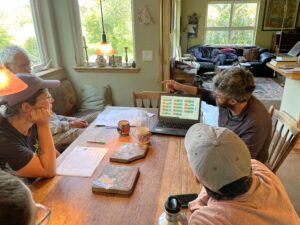
Midnight's Farm Interns Sept 2022 to present. We have had 12 interns engage on this project over the last two years. They have helped with bin construction, temperature monitoring, bulk density testing, turning and hydrating compost, taking samples, making potting media and had many, many conversations about clay, compost, organic matter, carbon , nutrient retention, nutrient cycling, experiment design, what we would do differently next time, etc. They also had the opportunity to participate in calls and on-farm visits with Dr. Doug Collins our technical advisor and Dr. Nathan Stacey who assisted in data interpretation. They were full participants in Aggregation 2023 and two Climate Farm Schools hosted on the farm. They assisted with the farm tours and school groups we hosted.
Aggregation 2023- A soil health intensive Sept 7-9, 2023 Hosted this three day gathering of farmers (14), technical advisors (11) and soil scientists (6) in a participatory learning and training environment that explored the interface of soil health science and on-farm carbon sequestration strategies. Participants were invited to discuss current research and share on-farm strategies.
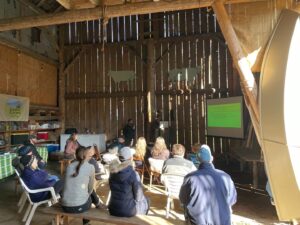
Lopez Island Farm Tours
- October 7, 2022 Presented the hypothesis and methods and showed the experimental bins as part of our farm tour. 45 participants. 4 farmers
- October 6 and 7, 2023 Presented about Climate, Compost and Biochar and gave an overview of findings from the experiment and showed the experimental bins. 53 participants. 6 farmers.
Rural Leadership Conference at the University of WA pre conference field trip November 17, 2022. Presented hypothesis, showed experimental bins and shared importance of on-farm research. 40 participants. 2 farm educators
Lopez Island High School Sustainable Agriculture Practices Class & Seattle Girls School
We hosted field trips on the farm during which we presented our hypothesis, showed students the experiments in process and did hands on activities teaching about compost.
- November 29, 2022. Lopez High School 20 students
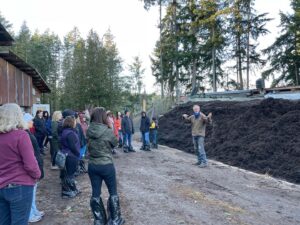
A compost tour which highlighted the clay in compost experiment - June 7, 2022 Seattle Girls School 15 students
- May 30, 2023 Lopez High School 16 students
Climate Farm School May 2022 (8 participants, 1 farmer and 4 agricultural professionals) and September 2023 (4 participants with 2 farmers and 2 agricultural professionals) presented the hypothesis and showed the experimental compost bins in process in 2022. In 2023 we shared the preliminary findings and demonstrated how to set up a bin.
Interns
Engagement with this project was a meaningful and rich experience for our farm interns. It provided a focus for learning and inquiry that went beyond the day to day operation of the farm. Individuals were able to take different aspects of the project, such as figuring out how to monitor and graph temperature, and contribute in a meaningful way.
Videos
With the inconclusive results of the experiments the videos allowed us to share results in a way that also told a story about the importance of on-farm research. With social media and access to community forums it was fairly easy to distribute the video and have a broader reach.
- Views (4/25/24-4/30/24) for Clay in Compost Experiment on Midnight's Farm
- YouTube- 427 views
- Instagram- 1,614 views
- Views (4/25/24-4/30/24) for Easy Aerated Compost Bin
- YouTube- 293 views
- Instagram- 662 views
Some comments posted about the videos:
- From YouTube- "Wow, soooo cool you tried this! I've been thinking a lot about trying clay or rock dust in my compost. Did you do 5% by weight or 5% by volume? I once watched a documentary by the Austrian compost company Sonnenerde ("Sun Earth") and they said they use a staggering 10% by volume of rock dust in their compost. I would love to know where you are going with this. I subscribed in a heartbeat!! I really appreciate you posted this despite results being inconclusive."
- From YouTube- "I have been thinking about exactly this for my chicken compost, what would happen if I added the clay. I have sandy soil locally, so I need more water and nutrient holding compost/amendments."
- From Facebook- "Excited to see further research."
- From Instagram-"Thank you for your work and for taking the time to make and share this video- best thing I’ve seen on the internet in ages!"
On-Farm Education
Whether a farm tour for the general public, school group or ag professionals, people responded positively to seeing on-farm research in action. We found that being able to show the compost bins opened up deeper conversations about compost and soil science.
- Aggregation 2023 answers from participants when asked if they would do anything new or different
- From an Ag Professional "Implement more scientific on-farm trials"
- From a Farmer "Better understand soil and compost test results"
Education and Outreach Outcomes
- We found that farmers, technical advisors and the general public who toured the farm and were able to see the experiment in progress were struck by the importance of on farm research and even when our results were inconclusive. We encourage on-farm demonstrations a part of SARE projects.
- Because we were flipping a soil health concept on its head (adding clay to organic matter instead of adding organic matter to clay) the experiment was a great segue to conversations about newer concepts in soil science such as mineral associated organic matter.
- Having interns directly involved in the experiment was a rewarding learning experience.
- Videos allow for storytelling and accessible information transfer that can be easily shared.
- Hiring experienced videographers makes a huge difference.
How to build a mobile, aerated compost bin
Importance of on farm trials
The concept of co-composting
Interest in mineral associated organic matter and other soil health concepts